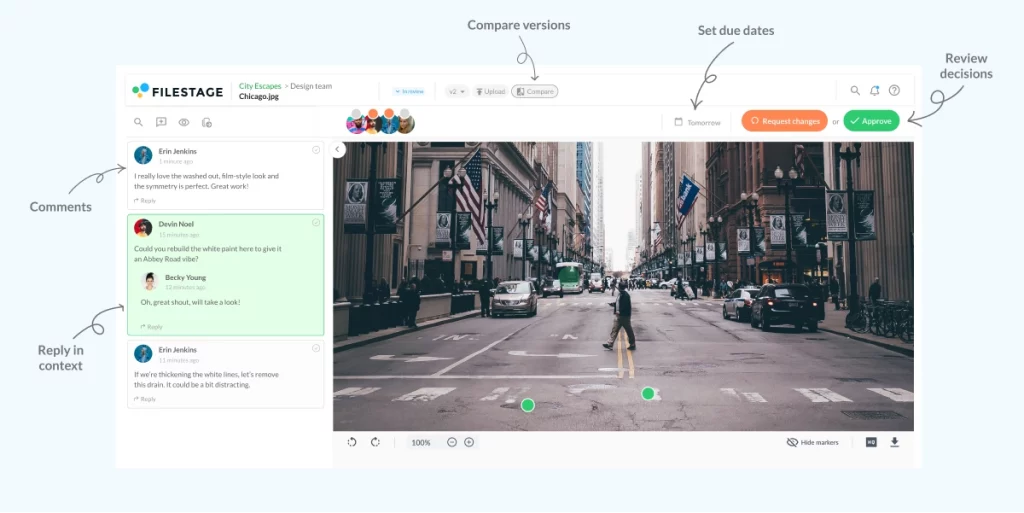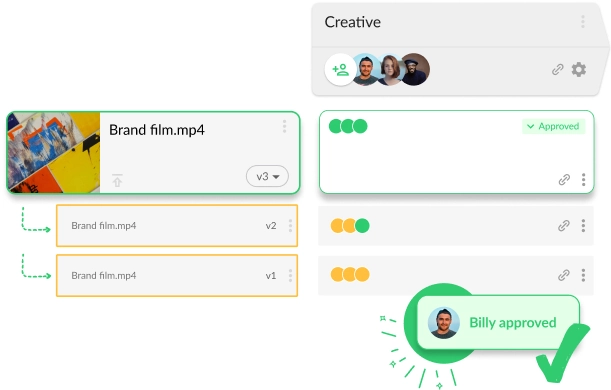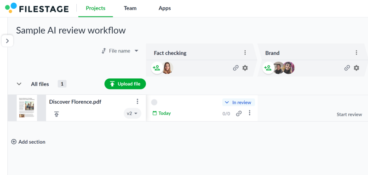If you’ve ever been on the receiving end of unclear or unconstructive content feedback (or worse, no feedback at all) you’ll know how frustrating it can be. Likewise, trying to give feedback on someone else’s content via a flawed content review process isn’t exactly a barrel of laughs either.
No matter which side you’re on, I’m here to help you kick chaos to the curb with a list of the biggest dos and don’ts for running an effective content feedback process.
But before that, let’s take a quick look at what we mean when we talk about content feedback.
What is content feedback?
Content feedback is an essential part of the content creation and content marketing process. It’s an overarching term for all the opinions, suggestions, and comments people share about a specific piece of content. For example: a video, blog post, or live web page.
Constructive feedback helps creative and marketing teams produce high-quality content by clearly pointing out different elements that could be improved.
Once discussed, content creators can then incorporate this feedback into the content by making revisions and edits as needed. After all feedback has been addressed and reviewed again, the approved content version is ready to be used or shared.
Supercharge your marketing reviews
Share, review, and approve all your content in one place with Filestage.
4 DOs of the content feedback process
If you feel like your marketing content review process is in need of some TLC, here’s a checklist of four key tips you can implement today.
1. DO give reviewers a collaborative space to share feedback
Before the rise of remote working, sharing content feedback usually meant hashing out thoughts and ideas with your team in a shared meeting space. But while we may not have the luxury of working under the same roof as often, that doesn’t mean the process needs to be any less collaborative.
Nowadays, how your organization handles virtual collaboration can make or break your entire review workflow. Which is why most modern teams use a content review tool like Filestage to facilitate more open and organized feedback sessions that keep collaborators on the same page.
Filestage makes it easy for teams to share, review, and approve all types of content in one user-friendly space. It’s also packed with features that make for more collaborative feedback, including:
- In-context comments for clear, accurate feedback in real time
- To-do lists that help your team make an effective plan of action
- Version history to help you keep track of comments and changes
- Due dates to keep your projects moving as planned
Using the right review tool will make for a more enjoyable feedback process, with no need to share and download chunky files over and over again. Whoop whoop!

2. DO set due dates for feedback
Rushed or late feedback isn’t fun for anyone involved, and this problem can be easily avoided with the right measures in place.
When sharing any piece of content for review, it’s important to make sure the reviewer knows when you need to receive feedback. Communicate due dates clearly to everyone involved and send reminders as the deadline approaches. This will make sure reviewers can give considered feedback and leave enough time for content creators to make the necessary changes.
The best feedback tools will usually have a feature to help you communicate and manage due dates.

3. DO keep track of feedback and file versions
Mistakes and miscommunications happen. Especially when you have multiple people providing feedback and tight timelines to meet. Which is why keeping track of comments, suggestions, and changes is an absolute must for teams of every shape and size.
By tracking and organizing file versions as you go, you’ll be able to maintain the accuracy and integrity of your content throughout the revision process. What’s more, it’ll be a lot easier to rectify any errors or changes of opinion when you have the past version of your file (and the one before that) to hand.

4. DO invite a diverse range of reviewers
Content feedback is only effective if it covers all bases of your project – e.g. tone, design, context, client preferences, customer feedback.
Inviting the right people to review content will help you collect feedback on every important element without overloading creators with too many unnecessary opinions. The best way to do this is by defining and assigning reviewer roles ahead of time.

4 DON’Ts of the content feedback process
Now that we’ve gone through the different things you can do to create a better content feedback process, it’s time to iron out the kinks with four things that you really ought to avoid.
1. DON’T send transfer links that time out in seven days
Time-limited file transfers can cause major delays in your content review process – I’m looking at you, WeTransfer. Plus, it’s just a major pain in the backside to have to ask someone to send a new link when they’re presumably already under time pressure.
Convenience is crucial when it comes to streamlining your content review process. So, instead of faffing about with ticking transfers, use Google Docs or – better yet – a file sharing or review platform that lets collaborators provide feedback at a time that works for them.
2. DON’T give vague feedback
“Make it pop!”
“Add more oomph!”
“Don’t like this… Not sure why.”
Positive feedback is great. Negative feedback is good, too. But vague feedback has got to go!
As a rule of thumb, if you can’t clearly explain your reasoning behind each piece of feedback, you need to dig deeper for more constructive, actionable thought.
Reading minds isn’t on most content creators’ resumes, so stick to relevant and accurate feedback that they can understand and implement.
3. DON’T have unnecessary review rounds
Easier said than done, I know. But a long back-and-forth between creatives and reviewers usually signals that there’s a problem with collaboration rather than the content itself.
The most effective way to reduce review rounds is by making sure everyone has enough contextual understanding before the project starts.
And this works both ways. Creatives need all the necessary information, while the reviewers do their homework on the content strategy and target audience to make sure they’re giving good feedback first time round.
4. DON’T forget about feedback once the project ends
There’s something to be learned from every project and every content feedback session. If you really want to continuously improve your review process, it’s important to stop and take a look back at each project to see what worked, what didn’t, and what could work better next time.
Most content review platforms will let you store and manage all file versions and project folders for easy access at any time.
Every content team is different, so make sure to check in and make tweaks to your feedback process based on the way you collaborate together. This will help you create a higher standard of work in less time with way fewer headaches!
Final thoughts
I hope you found this article helpful!
Your content feedback process plays a big role in the way you create content as a team. So it’s super important to approach it in the right way, with the right tools to help you along. If you’d like to see why Filestage is the go-to platform for getting faster final approval on your content, start your free trial today.







